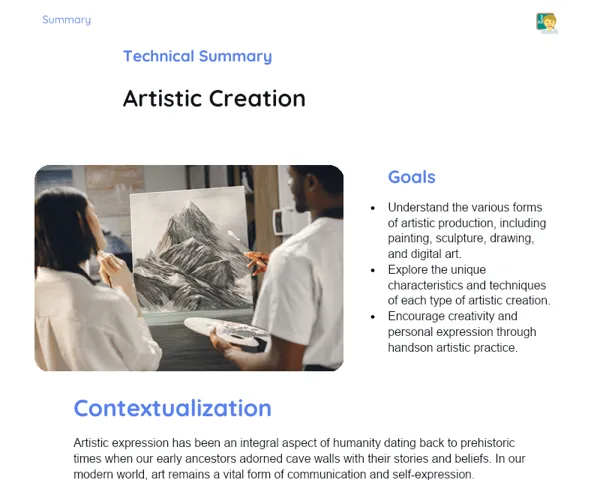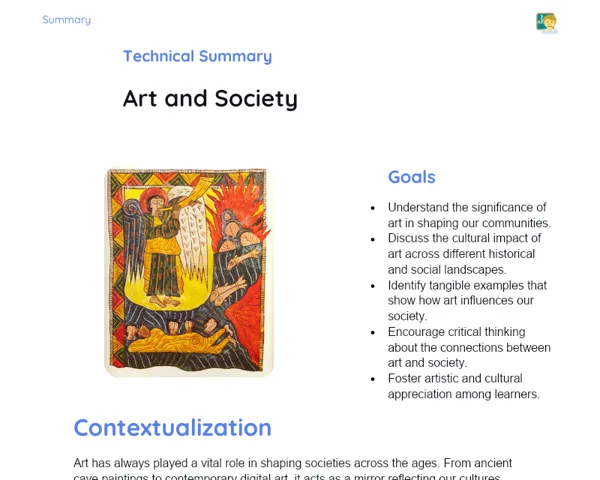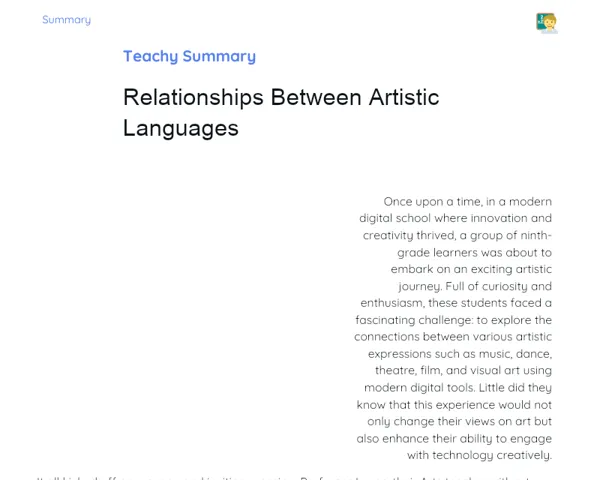Summary Tradisional | Islamic Art
Contextualization
Islamic art has a rich tapestry woven over a millennium and spans a wide geographical area, which includes parts of Europe, Africa, and Asia. This art form goes beyond mere religious expression; it encapsulates the culture, science, and milestones of Islamic societies throughout history. Notably, Islamic artworks stand out for their intricate designs, geometric harmony, and beautiful calligraphy, often encountered in mosques, palaces, and other historic structures.
In light of the Islamic prohibition against depicting human and animal figures in religious art, artists developed remarkable skills in creating geometric patterns and intricate arabesques. This artistic style has influenced not just architecture but also craft traditions like tapestry and goldsmithing, resulting in stunningly detailed and ornate works that continue to be cherished today. For instance, iconic Persian rugs, deeply rooted in Islamic art traditions, are considered masterpieces.
To Remember!
Introduction to Islamic Art
Islamic art traces its roots back to the 7th century, marked by the rise of Islam in the Arabian Peninsula, and has flourished across vast regions from Spain right through to India. A key feature of this art is the deliberate avoidance of human and animal images in religious portrayals, drawing from the Islamic interpretation of idolatry. As a result, artists focused on creating beauty through geometric patterns, calligraphy, and arabesques—decorative styles defined by intertwining lines and stylized floral designs.
These designs are omnipresent in mosques, palaces, and historical sites. The exceptional symmetry and intricate complexity conveyed in these forms reflect the pursuit of perfection and infinity, concepts often linked to divine essence. Additionally, Arabic calligraphy—especially familiar styles like kufic and naskh—serves both as a means of communication and as an artistic expression.
Islamic art transcends religious confines, capturing the cultural, scientific, and societal advancements of Islamic civilizations over the years. It can be expressed in various media, such as architecture, ceramics, tapestry, and goldsmithing, each revealing the unique craftsmanship and creativity inherent in Islamic artistry.
-
Began in the 7th century alongside the inception of Islam.
-
No representation of human or animal forms in religious settings.
-
Focus on geometric themes, Arabic calligraphy, and decorative arabesques.
Islamic Architecture
Islamic architecture stands out as one of the most recognizable and long-lasting art forms associated with Islam, featuring notable aspects like minarets, domes, and stunning mosaics. Minarets, the tall towers attached to mosques, serve the purpose of calling the faithful to prayer. The domes, often elaborately tiled, symbolize the heavens and are hallmarks of important Islamic constructions.
Landmark structures such as the Great Mosque of Córdoba, the Alhambra, and the Blue Mosque are prime examples of these architectural features. The Great Mosque of Córdoba, found in Spain, is celebrated for its unique horseshoe arches and intricate mosaics. The Alhambra in Granada is famed for its enchanting courtyards and fountains, along with its exquisite stucco craftsmanship. The Blue Mosque in Istanbul is distinguished by its grand domes and six elegant minarets, adorned with beautiful blue tiles.
These facilities function not merely as places of worship but are cultural emblems that showcase the sophistication and diversity of Islamic civilization. The essence of Islamic architecture has even influenced the design of secular buildings, such as palaces and fortifications, highlighting its vast cultural imprint.
-
Key features: minarets, domes, and mosaics.
-
Renowned examples: Great Mosque of Córdoba, Alhambra, Blue Mosque.
-
Cultural significance and influence on non-religious architecture.
Islamic Calligraphy
Islamic calligraphy is esteemed as one of the highest forms of art in the Islamic world, primarily due to the sacred significance of the Quran. It serves as both a communication medium and an art form that elevates the divine words. The two prevalent styles, kufic (more angular) and naskh (smoother), showcase diverse, artistic expressions.
Calligraphy frequently graces manuscripts, architectural elements, ceramics, and various artifacts. In manuscripts like the Quran, every letter is painstakingly crafted, forming not only a written document but also a visual and spiritual masterpiece. In architecture, calligraphic art can be seen in friezes, domes, and walls, where Quranic verses are prominently featured through carving or painting.
Moreover, Islamic calligraphy extends beyond religious contexts; it is often used decoratively. Many ceramics and metalworks boast beautiful calligraphic inscriptions, both enhancing the object's aesthetic appeal and imparting spiritual or poetic messages.
-
Holds significance because of the Quran.
-
Main styles: kufic and naskh.
-
Utilized in manuscripts, architectural design, and decorative crafts.
Tapestry and Goldsmithing
Tapestry and goldsmithing vividly showcase the influence of Islamic art. Islamic tapestry, particularly Persian rugs, is renowned for its elaborate and detailed patterns. These often feature geometric and floral designs influenced by traditional Islamic art. Persian rugs serve not only practical needs but are also revered as art pieces that reflect the talents of skilled weavers.
Similarly, Islamic goldsmithing exhibits intricate techniques in inlaying precious metals and creates complex decorative works. Islamic jewellery often incorporates floral and geometric motifs, with many pieces displaying poetic scriptures. These decorative items are laden with both beauty and symbolic significance.
Noteworthy examples include Qum rugs, celebrated for their detailed artwork and vibrant hues. In goldsmithing, pieces such as gemstone-adorned jewellery and ornately crafted metallic objects testify to the extraordinary skills of Islamic craftsmen.
-
Notable tapestries: Persian rugs.
-
Incorporation of geometric and floral designs.
-
Goldsmithing showcases inlaid precious metals and intricate decorative patterns.
Key Terms
-
Islamic Art
-
Islamic Architecture
-
Islamic Calligraphy
-
Tapestry
-
Goldsmithing
-
Geometric Patterns
-
Arabesques
-
Art History
-
Cultural Influences
-
Islamic Faith
-
Great Mosque of Córdoba
-
Alhambra
-
Blue Mosque
-
Calligraphic Styles
-
Persian Rugs
-
Inlay of Precious Metals
Important Conclusions
Islamic art is an extensive and varied domain that covers more than a thousand years of history, reaching across numerous geographical areas, including parts of Europe, Africa, and Asia. Its distinctive style, characterized by the deliberate exclusion of human and animal imagery in religious art and the mastery of geometric patterns, calligraphy, and arabesques, mirrors the cultural, scientific, and societal legacies of Islamic civilizations.
Architectural masterpieces like the Great Mosque of Córdoba, the Alhambra, and the Blue Mosque illustrate these unique artistic traits perfectly. Islamic calligraphy, deeply valued for its ties to the Quran, not only facilitates communication but also adds a decorative and spiritual layer to the art. Styles like kufic and naskh enrich manuscripts, architecture, and decorative objects, enhancing the spirit and beauty of Islamic pieces. The realms of tapestry and goldsmithing reveal the art's influence through complex patterns and sophisticated craftsmanship.
Studying Islamic art is crucial for appreciating the cultural and artistic contributions of Islamic societies. Moreover, elements of this fascinating tradition are often echoed in contemporary design and modern architecture, emphasizing its lasting relevance and impact. Encouraging students to delve deeper into this topic can significantly broaden their understanding of the cultural and artistic richness of the Islamic heritage.
Study Tips
-
Go over the notes taken during class and check them against the Content Summary to strengthen your understanding.
-
Engage in online research or explore art history literature on more Islamic constructions and artworks to expand your knowledge base.
-
Visit museums, exhibitions, or browse websites dedicated to Islamic art collections to observe the details and techniques we've discussed in class.



